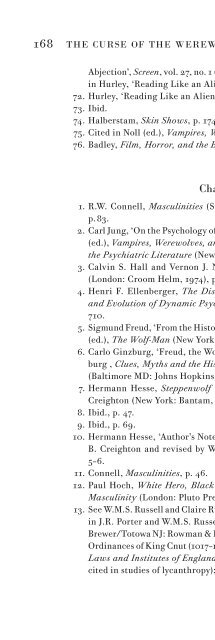The Curse of the Wer.. - Site de Thomas - Free
The Curse of the Wer.. - Site de Thomas - Free
The Curse of the Wer.. - Site de Thomas - Free
Create successful ePaper yourself
Turn your PDF publications into a flip-book with our unique Google optimized e-Paper software.
168 THE CURSE OF THE WEREWOLF<br />
Abjection’, Screen, vol. 27, no. 1 (January–February 1986), pp. 62, 68; cited<br />
in Hurley, ‘Reading Like an Alien’, p. 209.<br />
72. Hurley, ‘Reading Like an Alien’, pp. 209–11.<br />
73. Ibid.<br />
74. Halberstam, Skin Shows, p. 174.<br />
75. Cited in Noll (ed.), Vampires, <strong>Wer</strong>ewolves, and Demons, p. 83.<br />
76. Badley, Film, Horror, and <strong>the</strong> Body Fantastic, p. 3.<br />
Chapter 4<br />
1. R.W. Connell, Masculinities (St Leonards NSW: Allen & Unwin, 1995),<br />
p. 83.<br />
2. Carl Jung, ‘On <strong>the</strong> Psychology <strong>of</strong> <strong>the</strong> Unconscious’, quoted by Richard Noll<br />
(ed.), Vampires, <strong>Wer</strong>ewolves, and Demons: Twentieth Century Reports in<br />
<strong>the</strong> Psychiatric Literature (New York: Brunner/Mazel, 1992), p. xvii.<br />
3. Calvin S. Hall and Vernon J. Nordby, A Primer <strong>of</strong> Jungian Psychology<br />
(London: Croom Helm, 1974), pp. 41–53.<br />
4. Henri F. Ellenberger, <strong>The</strong> Discovery <strong>of</strong> <strong>the</strong> Unconscious: <strong>The</strong> History<br />
and Evolution <strong>of</strong> Dynamic Psychiatry (New York: Basic Books, 1970), p.<br />
710.<br />
5. Sigmund Freud, ‘From <strong>the</strong> History <strong>of</strong> an Infantile Neurosis’, in M. Gardiner<br />
(ed.), <strong>The</strong> Wolf-Man (New York: Basic Books, 1971), p. 239.<br />
6. Carlo Ginzburg, ‘Freud, <strong>the</strong> Wolf-Man, and <strong>the</strong> <strong>Wer</strong>ewolves’, in C. Ginzburg<br />
, Clues, Myths and <strong>the</strong> Historical Method, trans. J. and A. Te<strong>de</strong>schi<br />
(Baltimore MD: Johns Hopkins University Press, 1992), p.154.<br />
7. Hermann Hesse, Steppenwolf (1927, English trans. 1929), trans. Basil<br />
Creighton (New York: Bantam, 1969), pp. 46–7.<br />
8. Ibid., p. 47.<br />
9. Ibid., p. 69.<br />
10. Hermann Hesse, ‘Author’s Note’ (1961), in H. Hesse, Steppenwolf, trans.<br />
B. Creighton and revised by W. Sorell (London: Allen Lane, 1974), pp.<br />
5–6.<br />
11. Connell, Masculinities, p. 46.<br />
12. Paul Hoch, White Hero, Black Beast: Racism, Sexism and <strong>the</strong> Mask <strong>of</strong><br />
Masculinity (London: Pluto Press, 1979), p. 16.<br />
13. See W.M.S. Russell and Claire Russell, ‘<strong>The</strong> Social Biology <strong>of</strong> <strong>Wer</strong>ewolves’,<br />
in J.R. Porter and W.M.S. Russell, Animals in Folklore (Cambridge: D.S.<br />
Brewer/Totowa NJ: Rowman & Littlefield, 1978), p. 166; <strong>the</strong> Ecclesiastical<br />
Ordinances <strong>of</strong> King Cnut (1017–1035), reprinted in B. Thorpe (ed.), Ancient<br />
Laws and Institutes <strong>of</strong> England (London: 1840), pp. 160–161 (frequently<br />
cited in studies <strong>of</strong> lycanthropy); Mary R. Gerstein, ‘Germanic Warg: <strong>The</strong>





